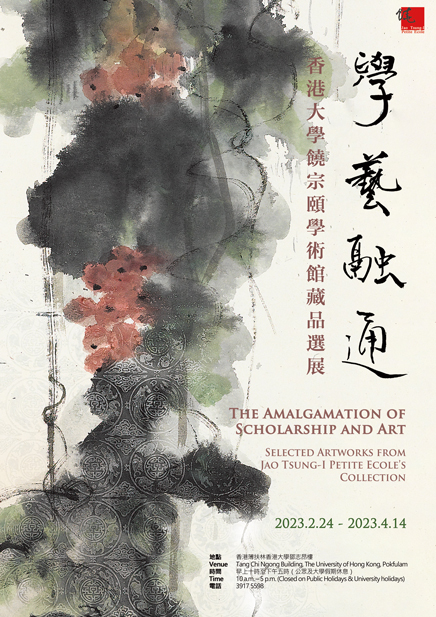藝術
學 藝 融 通 —— 香港大學饒宗頤學術館 藏品選展
The Amalgamation of Scholarship and Art: Selected Artworks from Jao Tsung-I Petite Ecole
| 日期: | 2023年2月24日 - 4月14日 |
| 時間: | 上午10:00 - 下午5:00(星期一至五) (公眾及大學假期休息) |
| 地點: | 香港大學饒宗頤學術館(香港 薄扶林 香港大學 鄧志昂樓) |
| 查詢: | 3917 5598 |

前言
香港大學饒宗頤學術館在二零零三年創立時,饒宗頤教授所捐贈之兩個重要項目,可以說是創館的其中重要支柱。這些捐贈項目包括饒教授使用過的超過三萬冊藏書,其中古籍善本約數百種。另一項重要捐贈,是他歷年所創作的書、畫、文玩。
饒教授從他數十年來的創作中,選取了具有代表性的作品。而且,在開館之後的數年,饒教授還陸續把他的新作捐為館藏,現今數量超過二百件。這些藝術作品不單止標誌著饒宗頤教授個人的創作歷程與成就,同時亦可以見到一位學者與藝術家,他如何在學術與藝術之中,雙頭並進,學藝互益。
饒宗頤教授在藝術創作的路途上,顯示出他巨大的創新力量。在踏進二千禧年之後,饒教授在他超過九十高齡時,依然在書法、繪畫上有篳路藍縷的開創。他的古文字書法、動力澎湃的行草、山水畫西北宗的畫法、創新的敦煌白描、與及氣勢磅礡的荷花等,都可以見到他在書畫兩者不拘成法、不拘所謂中西畫法之別的觀念,自由地驅使書畫工具與技法來創作。他的作品在近代藝術史上一定會佔重要的一頁。
自古以來,在學術與藝術兩方面,都能有過人的成就者,為數不多。大家時常提到的,也不過是宋代的蘇東坡及明末的方以智。所以,現今的藝術評論家對饒教授的藝術創作都給以極高評價。因為他證實了中國傳統書畫藝術絕對是長流不息,是具有無限的生命力。
香港大學饒宗頤學術館這批藏品,就是這一種生命力的明證。
李焯芬
Foreword
When Jao Tsung-I Petite Ecole of The University of Hong Kong was established in 2003, Professor Jao Tsung-i contributed two sets of donations, which can be regarded as the major portion of this academic institute. The contributions consist of over 30,000 book collections of Professor Jao’s, which includes hundred kinds of wood board printed editions of the Ming and Qing dynasties. The other part of the contributions comprises his calligraphy, paintings and studio objects accomplished over the years
Professor Jao selected his most representative works from those had done in the past decades. Moreover, he had consecutively donated his new art works as the collections of Jao Tsung-I Petite Ecole, with more than 200 items. These artworks not only symbolize Professor Jao’s artistic development and achievements, but we can also learn how a scholar artist can reach great attainments in both fields.
Professor Jao revealed his innovation ability in the process of art creation. After the year of 2000, Professor Jao still made strenuous efforts to develop new directions in the realms of calligraphy and painting in his 90s. Not being limited by the regulations of painting and calligraphy as well as the boundary between Chinese and Western painting, he consummately wielded calligraphy and painting instruments and techniques, which were presented through his ancient character calligraphy, forceful running-cursive script calligraphy, Northwestern School landscape painting style, pioneering Dunhuang sketch technique, and tremendous momentum in lotus paintings. He unquestionably played an important role in contemporary art history.
Since ancient times, there have been few people excel in both academic and artistic fields. The most representative scholar artists are Su Shi of the Song dynasty and Fang Yizhi of the late Ming dynasty, and modern art critics consequently have high estimation of Professor Jao’s artworks because he demonstrated that the stream of traditional Chinese painting and calligraphy is endless and of boundless vitality.
Undoubtedly, this collection of Jao Tsung-I Petite Ecole of The University of Hong Kong is a strong proof.
C. F. Lee
